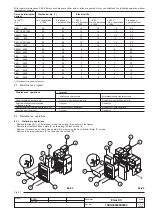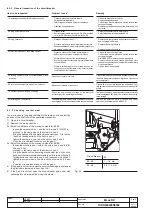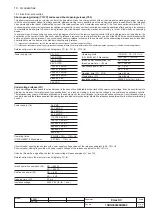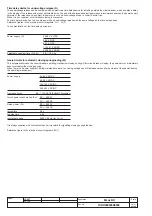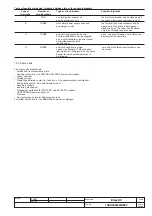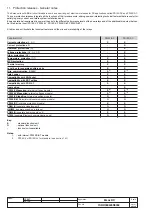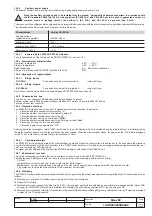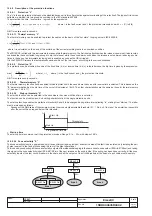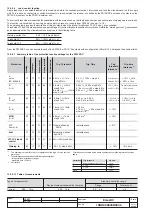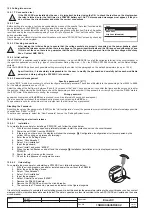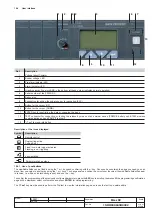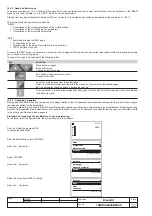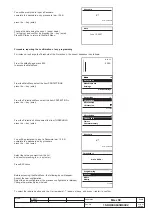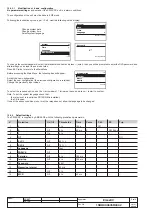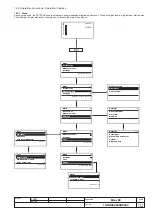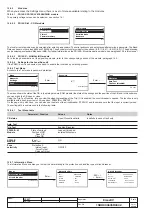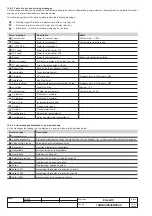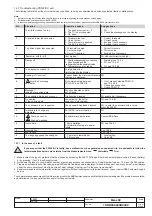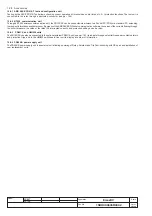
L3447
Emax DC
33/108
Model
Scale
Page No.
Doc. No.
Apparatus
1SDH000635R0002
L3728
As a practical example, the figure above shows a fault on the load side of the "Relay 1a" isolated by the latter without the "Relay 1" or the "Relay
0" being affected; a fault immediately downstream from the "Relay 1" will be isolated by the latter without the "Relay 0" being affected, thus ensuring
that the Areas 2...n remain operational.
The ZSO output can be connected to a maximum of 20 ZSI relays on the supply side in the selectivity chain.
The maximum length of cable for zone selectivity, between two units, is 300 meters.
Use corded shielded two-wire cable (see note A to par. 11.2.2).
The shield must only be earthed on the circuit-breaker of the supply-side relay (ZSI side).
Operation is only guaranteed when there is an auxiliary voltage.
The following logical table is implemented to manage the Zone Selectivity Input (ZSI) and Zone Selectivity Output (ZSO) signals:
Zone selectivity
Imax > I
2
ZSI signal
ZSO signal
Trip T
Excluded
NO
0
0
No trip
Excluded
NO
1
0
No trip
Excluded
YES
0
0
t
2
programmed
Excluded
YES
1
0
t
2
programmed
Inserted
NO
0
0
No trip
Inserted
NO
1
1
No trip
Inserted
YES
0
1
t
selectivity
Inserted
YES
1
1
t
2
programmed
The time t
2
must be set at a value higher than or equal to t
selectivity
+50ms, on the CB on the supply side, not required on the first one in the chain.
12.2.9.3
Protection “I”
The protection is enabled/disabled from the menu.
In the case where zone selectivity "S" is active, during the trip of the relay for "I", the ZSO output signal is activated in any case to guarantee correct
operation of the relay on the supply side.
12.2.9.3.1 Start-up threshold “I”
The start-up function can be selected.
The function can be enabled from the menu on the protection "I" page.
The function behaves in exactly the same way as the protection "S" (see par. 12.2.9.2.2).
12.2.9.4
Protection “MCR” against closing on short-circuit
The MCR function is used to protect the system against closing, if any, on short-circuit.
This protection goes on when the CB is closed, within a time window ranging from 40 to 500ms and with a threshold as set by customer, using
the same algorithm as protection I. This protection can be disabled and is an alternative to protection “
I
”.
This function can be activated through a hand-held PR010/T unit via SD-Testbus2 and SD-Pocket softwares or through a remote system via a system
bus. This function has one fixed-time protection curve only.
12.2.9.5
Protection against overtemperature inside the relay “OT”
There is a sensor inside the PR122/DC unit that monitors the temperature of the unit.
This enables the signalling of any abnormal temperature conditions, which could cause temporary or continuous malfunctions of the unit's electronic
components.
This protection has two states of operation:
State of
“WARNING TEMPERATURE”
with
–25 °C < temp. < -20 °C
or
70 °C < temp. < 85 °C
: the display is turned off
and the "WARNING" LED flashes at 0.5Hz
State of
“ALARM TEMPERATURE”
with
temp. < –25 °C
or
temp. > 85 °C
: the display is turned off,
the "WARNING" and “ALARM” Leds flash at 2Hz and the Trip is activated (if enabled by means of the "Over Temper. Trip = On" parameter)
N.B.:
In the event of Warning and Alarm, the display is turned off, to preserve its functionality.
The monitored temperature is not visible on the display.
The protection is always active, both with auxiliary supply and in self-supply.
Disabling the Trip control of the protection means that the PR122/DC unit could work, with the circuit-breaker closed, in a
range of temperatures where correct operation of the electronics is not guaranteed.

